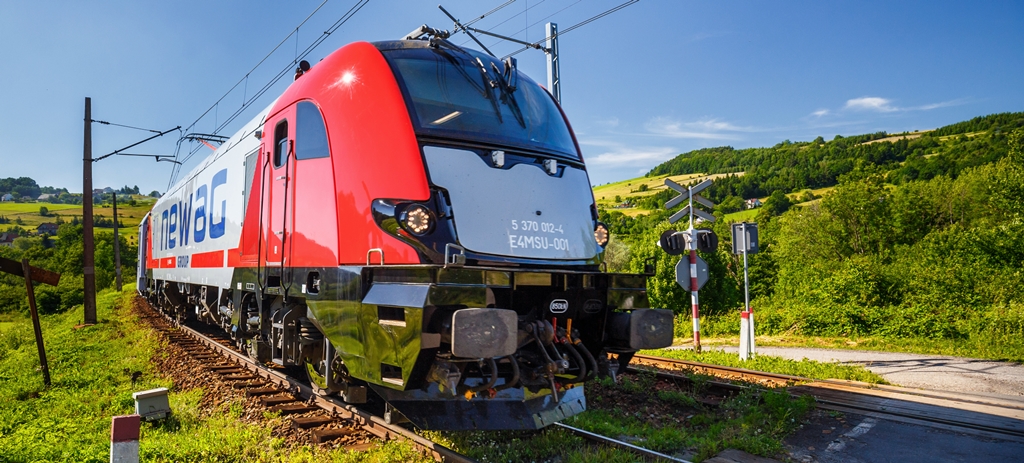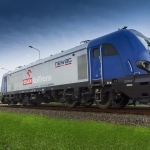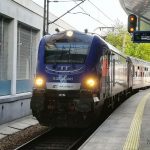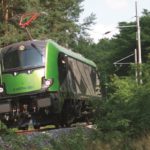A multi-system GRIFFIN is the first traction vehicle from the family of four-axle electric and diesel locomotives, offering their users the whole range of transport and technical possibilities.
The locomotive is intended to pull freight trains of a weight of up to 3200t with the speed of up to 140 km/h and passenger trains with the speed of up to 200 km/h.
Technical parameters of GRIFFIN are tailored to users’ individual requirements. It is characterised by the highest safety level, full amenities, high comfort of the driver’s work, and the intelligent system of energy management. Thanks to its modular structure, GRIFFIN is offered in several versions based on maximum number of common components.
Some of the basic features of GRIFFIN include motors powered by IGTB-based traction inverters, the on-board diagnostics system with comprehensive visual information and a data recording module or the camera system. The loco is adapted for ERTMS and GSM-R installation.
Meeting the EU and UIC requirements, the locomotive has not lost another of its major advantages, namely its competitive price.
GRIFFIN is an ideal response to varied needs of the European market therefore it had its official unveiling during the INNOTRANS 2012 International Trade Fair in Berlin.
The company’s production system and high standards confirmed by such certificates as the International Railway Industry Standard IRIS (manufacturing, design, development and maintenance activity for the locomotives) and the PN-EN ISO 9001:2009 guarantee the highest European quality of GRIFFIN locomotive.
![]() Performance characteristics:
Performance characteristics:
- Technical parameters tailored to users’ individual needs;
- Capable of pulling freight trains of the maximum weight of up to 3200t as well as passenger trains with the maximum weight of up to 800t;
- Asynchronous drive;
- Motors powered by IGBT-based inverters;
- Microprocessor-based steering system;
- On-board diagnostic system with full visual information and a data recording module;
- Ingenious use of electricity;
- High technical availability;
- Adapted for ERTMS and GSM-R installation;
- Modular structure;
- The highest safety level;
- Spacious driver’s cab compliant with the EN 1527 standard;
- Integral welded structure with crumple zones;
- Safety cage with anti-climbing system;
- Modern fire detection and extinguishing system;
- Camera system;
- Adapted for ERTMS and GSM-R installation;
- Enhanced driver’s working conditions;
- Full amenities;
- Environmentally friendly technologies;
- Economical;
- Ccompetitive price.
![]() Bogies:
Bogies:
- Two two-axle bogies in the Bo’Bo ’ system with individual drive for each axis;
- Welded hollow-girder frame construction;
- Transmission of traction force through the pin and draft bar attached to the frame;
- Lubrication system for wheel flanges with biodegradable grease;
![]() Powertrain:
Powertrain:
- Monoblock wheels with a nominal diameter of 1250 mm;
- Braking discs fixed on both sides of the wheel;
- Asynchronous traction cage motors with power of 1400 kW each;
- Independent cooling of each motor;
- Spur gear;
- Axle bearing with conical roller bearings, temperature and speed sensors.
![]() Suspension:
Suspension:
- Primary level: two sets of coil springs mounted directly on both sides of the wheelset axle box;
- Secondary level: set of large-scale spiral flexicoil springs;
- Hydraulic shock absorbers for muffling vertical vibrations
![]() Loco body:
Loco body:
- Integral welded design;
- Crumple zones;
- Ssafety cage in driver’s cab;
- Anti-climbing system;
Modular structure; - Roof divided into three sections offering easy access to the machinery compartment;
- Ergonomic, two-persons loco cab;
- Double function air conditioning system;
- Four cameras acting as rear view mirrors;
- Two cameras showing the image of draw-bars and screw couplings;
- Modern fire detection and extinguishing system.
![]() High voltage electrical circuits:
High voltage electrical circuits:
- Two or four single-arm pantographs with independent control system and anti-drop system;
- Highly reliable UR26 high-speed current limiting air circuit breaker made by Secheron;
- Interference filters;
- Traction transformer to lower the overhead line voltage of 15 kV16,7Hz or 25kV/50Hz suitable for traction converters;
- Two blocks of power supply to the drive, each equipped with two AC/DC converters;
- Three-phase inverters with IGBT transistors and a DC/DC converter to adjust electro-dynamic breaking power;
- 2 x 130 kW static converter of the output voltage of 3 x 440 V AC, 60 Hz and 24 V DC;
- Individual lubricant cooling system for each of the supply blocks.
![]() Low-voltage electrical circuits:
Low-voltage electrical circuits:
- 24V constant voltage obtained from an additional battery charger powered with 3×440 V. Providing power supply to: steering circuits, high-speed circuit-breaker, measuring converters control system, battery charging system, control panel equipment, pneumatic steering system, interior and exterior lighting, windscreen wipers.
- Top-class 335Ah FNC battery system;
- Loss of supply from the overhead line does not lead to switching off external lighting for 5 hours. When not used, the control system switches off all unnecessary receivers to save power.
![]() Loco diagnostic and control:
Loco diagnostic and control:
- Microprocessor — based control system;
- Main loco controller;
- Drive controller;
- Two independent panels to display drive parameters and diagnostics in each cab;
- Event recorder synchronized to the electronic speedometer;
- Ready for GPS-based equipment showing diagnostic data.
![]() Functions:
Functions:
- Overall control of locomotive operation;
- Setting the tractive effort;
- Fully automatic drive control with speed set by loco driver;
- Starting and breaking process controlled by anti-slip system individually on each wheelset;
- Control of pneumatic system;
- Adjustment of the electro-dynamic breaking power;
- Full locomotive diagnostics with the event recording.









